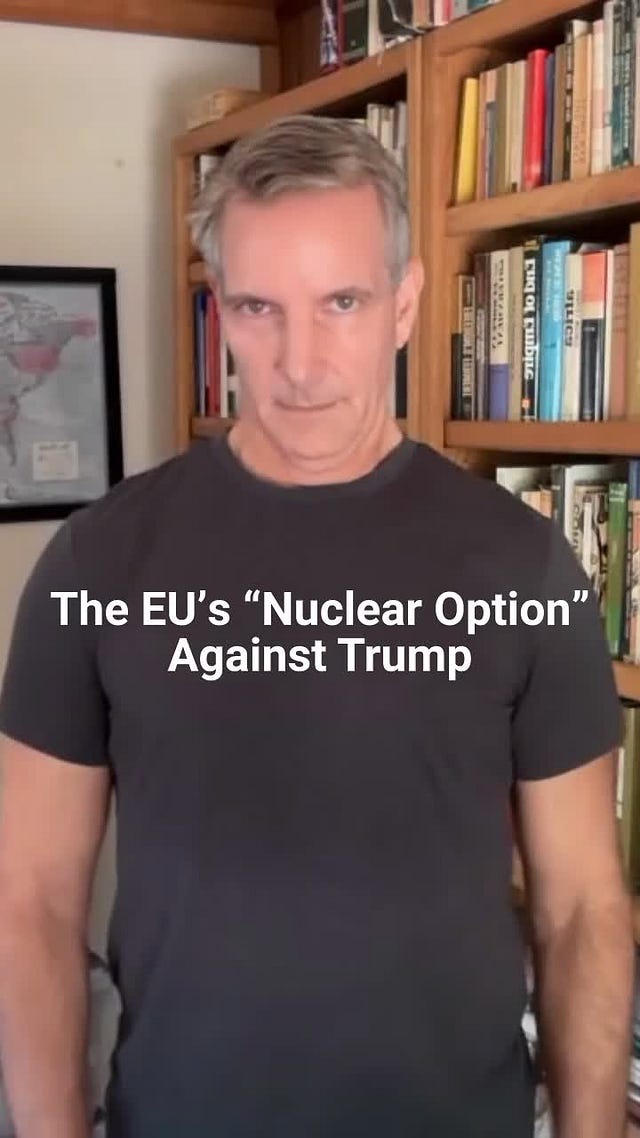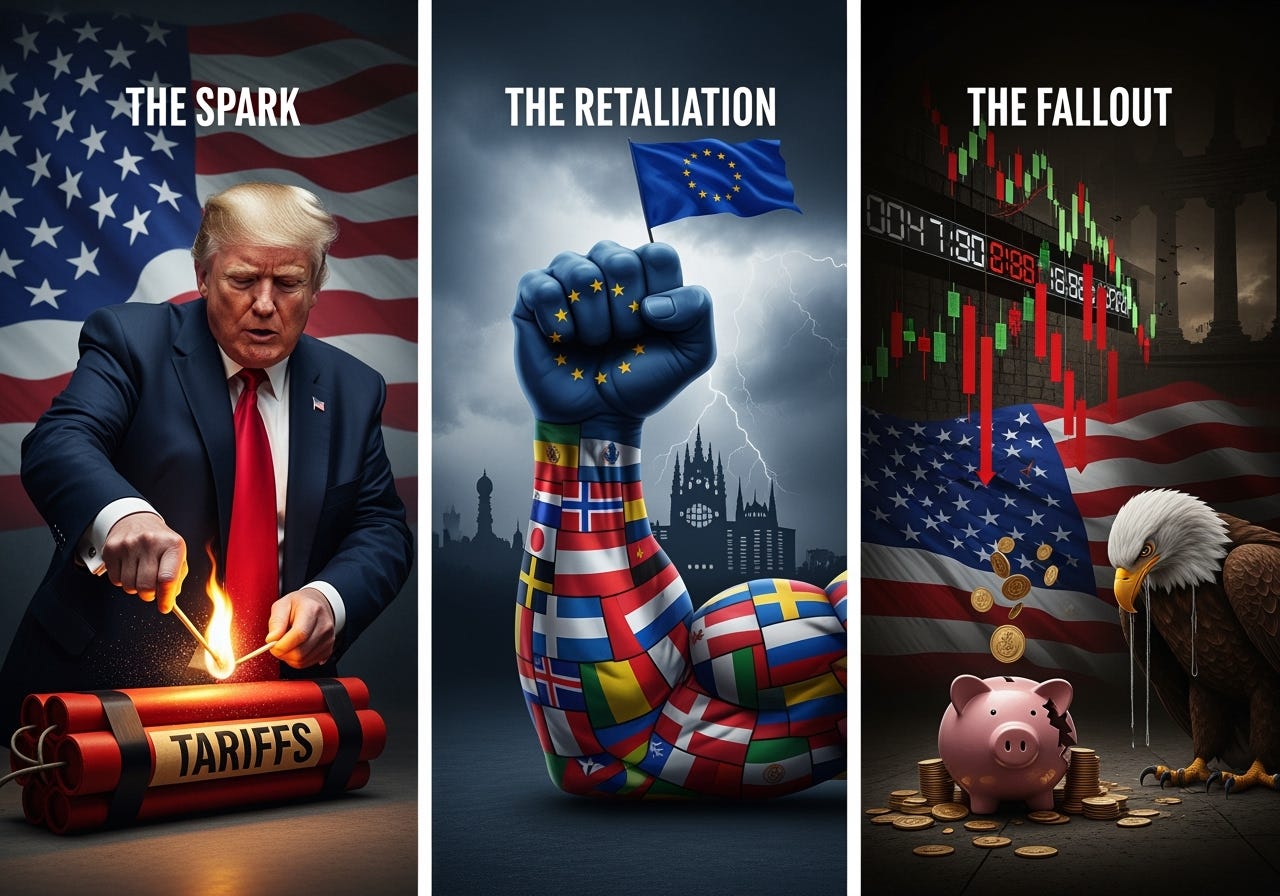Core Brief: Europe Prepares Its Trade “Nuclear Option” Against Trump
Trump escalated the trade war. Europe built a weapon to end it.
Trump started it. Europe will end it. America will suffer.
Trump started an aggressive trade war out of nowhere. Europe has been patient. Two cultural perspectives, aggressiveness and patience (achievement vs. nurturance) at odds. And a game-ending error dictators make when dealing with democracies, mistaking patience for weakness.
What’s Happening
Professor Sarah C. M. Paine, Professor of History and Grand Strategy at the U.S. Naval War College, famously said, “Pay attention to what dictators say . . . They quite often tell you exactly what they want to do.” Trump did just that. In 2016, he stated that he would initiate a trade war. The EU listened and prepared.
The EU began developing the Anti‑Coercion Instrument (ACI) in 2016 after Trump imposed the first set of tariffs and said he would escalate the trade war. The EU designed a tool that not only bypasses the requirement for full EU member agreement but also devastates the ‘attacking’ country.
The ACI authorizes severe countermeasures so severe that they were not intended for use, but as a deterrent, similar to nuclear weapons.
With Trump now threatening 30% car tariffs, the EU is preparing to use the weapon it built for this scenario, but hoped it would never have to use.
The ACI enables collective retaliation against foreign economic coercion by:
Imposing steep tariffs on US energy and agricultural exports, capping American biotech shipments, and tightening approvals for US-made industrial and medical equipment.
Barring US defense and engineering firms from billion-dollar European security and infrastructure projects
Blocking US banking services, streaming, and social media, including JPMorgan, Citibank, Amazon, Netflix, and Facebook (Meta).
Suspending US patent protections, delaying approvals for key American chemical and food products, and capping US investment in EU supply chains.
The ACI essentially locks US firms out of Europe’s public contracts, cuts American tech platforms from half a billion consumers, and restricts access to critical markets in finance, food, and pharmaceuticals.
France and Germany are leading the push for ACI implementation if negotiations fail or US measures are deemed coercive.
Why It Matters
The ACI marks a fundamental shift in global trade power. For 80 years, the United States wielded tariffs and sanctions as unilateral pressure tools, knowing most nations lacked the capacity or cohesion to respond in kind. The ACI removes that advantage. For the first time, the European Union can strike back, not with symbolic tariffs, but with sweeping, system-wide restrictions.
If activated, it would trigger a seismic shift in transatlantic commerce, ending US corporate dominance in a market worth nearly $1 trillion, slashing revenue streams for key industries from agriculture to tech, and accelerating the fragmentation of the global economy into rival trade blocs. American firms would face long-term exclusion from procurement contracts, digital markets, and regulatory pathways they’ve relied on for decades.
But it will have a greater effect than economic ruin. The ACI rewrites the balance of power. It breaks Europe’s dependence on the US to define trade norms and impose its economic will. Global trade rules will no longer be written in Washington.
The Cultural Perspective
Trump assumes the US can control global outcomes by imposing his will (internal direction). His tariff strategy reflects a monochronic orientation, demands, deadlines, measurable outcomes, and one-sided timelines. His tactics are rooted in an achievement-oriented culture, where power is earned through dominance and coercion when the other party will not submit.
The EU’s ACI is designed to counter dominance and coercion and balance the situation (external direction). Its activation would apply equally to all 27 EU nations in a unified response (collectivist and universalist). The ACI’s gradual, layered rollout also reflects polychronic time, multiple steps, evolving strategy, and relational pacing.
What’s Next
Should trade negotiations fail, the EU is expected to implement the Anti‑Coercion Instrument.
Short-term impact:
US companies will see immediate losses in revenue and contracts, particularly in defense, tech, and agriculture. Firms like Amazon, JPMorgan, and Boeing risk being shut out of billion-dollar deals, while US exports face higher barriers to entry. Stock markets may react with volatility as the threat of a full-scale trade war escalates.
Medium-term impact:
Europe would accelerate efforts to localize supply chains and invest in digital, defense, and agricultural self-sufficiency. American firms would begin losing long-held dominance in sectors like cloud computing, streaming, and finance. US retaliation could further damage trade flows, leading to higher costs for consumers and businesses on both sides.
Long-term impact:
The ACI’s full deployment would institutionalize a divided global economy. The US and EU would drift into separate regulatory spheres, with competing standards and reduced interoperability. Europe would emerge as a fully independent trade power, while the US would face declining global leverage. It will no longer be able to dictate economic terms unilaterally. Rival powers like China, India, and BRICS+ would exploit the split to expand their influence.
If enacted, global trade will no longer be under American control.
For the moment, Trump got lucky; Europe bought more time by pacifying Trump with an oral agreement. No deals have been signed. At least one demand made by Trump, buying energy from the US, is impossible since the US does not produce enough oil or gas to fulfill the agreement.
The ACI is still on the table. The EU has legally agreed to nothing. And Trump has no idea what he’s agreed to.
Join us for more cultural perspectives on YouTube and TikTok:

 Tiktok failed to load.
Tiktok failed to load.Enable 3rd party cookies or use another browser



